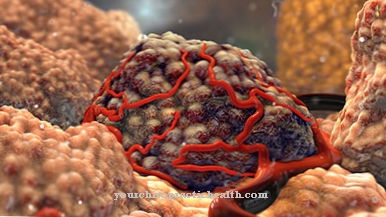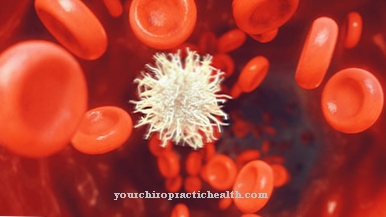Inguinal lymphogranuloma is a sexually transmitted disease caused by the pathogen Chlamydia trachomatis. In the western world, however, the venereal disease is rather rare.
What is inguinal lymphogranuloma?
Lymphogranuma inguinale is also under the name Lymphogranuloma venereum, venereal granuloma or Nicola Durand Favre Disease. The disease is transmitted sexually. It is extremely rare to find in the western world. It occurs predominantly in the tropics. Pathogens are different forms of Chlamydia trachomatis. If left untreated, the disease can become chronic. Treatment is usually with antibiotics.
causes
Lymphogranuloma inguinale is transmitted during sexual intercourse. It is one of the sexually transmitted diseases (STD). The cause of the disease is the bacterium Chlamydia trachomatis. It is a gram-negative bacterium that lives intracellularly. It occurs in different serotypes and thus also causes different diseases.
Serotypes L1 to L3 are the cause of lymphogranuloma venerum. Chlamydia trachomatis is one of the most common causes of sexually transmitted infections worldwide. There are around 90 million new infections with chlamydia every year. Most of the time, however, these are other serotypes. The incidence of lymphogranuloma inguinale is decreasing worldwide. However, the disease is still widespread in Africa, Asia, South America and the Caribbean.
Most infections occur between the ages of 20 and 30. As a rule, people with a lower social status are more likely to be affected. Several infections have been found in Germany since 2000. HIV-infected men are particularly affected. The Seroytp L2 is predominant here.
Symptoms, ailments & signs

© GraphicsRF - stock.adobe.com
It takes three to twelve days from infection to the appearance of the first symptoms. A painless blister forms at the infection site. The clinical manifestation of this primary stage depends on the entry site of Chlamydia trachomatis. If the penis or vagina is infected, the blister breaks down very quickly. An ulcer forms. This is only a few millimeters in size and is also painless. After a few days the ulcer will recede spontaneously.
If the pathogen was transmitted during anal intercourse, the rectum is affected. Here, the primary stage usually goes unnoticed. Oral intercourse can also affect the lining of the mouth and throat. This variant of the disease is rather rare, however, if the lymphogranuloma inguinale is not treated in the first stage, the secondary stage follows. After a latency period of a few days up to several weeks, the pathogens spread through the body via the lymphatic system. There is inflammation of the lymphatic system (lymphangitis) and inflammation of the lymph nodes (lymphadenitis).
The lymph nodes in particular are extremely painful. One speaks here of pressure-tolerant "Bubonen". If the portal of entry is in the area of the genitals, the genital lymph nodes, the inguinal lymph nodes and the lymph nodes around the anus are affected. In the course of the inflammation, tissue meltdown occurs. The result is abscesses and fistulas. The skin over the lymph nodes turns blue. The tissue in the area of the inflammation becomes thinner and thinner until the abscesses finally break through and drain their pus to the outside.
These symptoms are usually accompanied by fever, muscle pain, headache and joint pain. Women may also develop inflammation of the uterus (cervicitis) or ovaries (salpingitis). Inflammation of the uterus causes pain and itching. A purulent vaginal discharge is also characteristic. Salpingitis is also accompanied by pain and discharge.
Rectal infection can result in proctitis or proctocolitis. Without treatment, the disease becomes chronic and enters the tertiary stage. A fistula formation in the affected sections of the lymphatic system is typical here. Parts of the system are also converted into connective tissue (fibrosis). This disrupts the lymphatic drainage, which can lead to lymphedema. Very pronounced lymphedema can lead to elephantiasis in the genital area.
Diagnosis & course of disease
The aim of diagnostics is to detect pathogens. The DNA of the pathogen is detected by means of PCR from a swab of the vesicles or from the fluid from a lymph node. However, methods such as direct immunofluorescence detection (DFA) or the ELISA search test can also be used. However, cultivating the pathogen on special media is rather difficult and very time-consuming and is therefore only carried out in exceptional cases. When making a diagnosis, it is important to distinguish it from similar diseases such as granuloma venereum, syphilis or ulcus molle.
Complications
In the case of lymphogranuloma inguinale, those affected primarily suffer from complaints of the genitals. These complaints are very uncomfortable for most people, so that they feel ashamed and possibly also suffer from inferiority complexes or from reduced self-esteem. Blisters also form on the genitals, which lead to pain.
An ulcer can also develop and significantly reduce the quality of life of the person affected. Furthermore, the sexual intercourse of the person concerned is significantly restricted by the lymphogranuloma inguinale, so that tensions with the partner can arise. The disease can also spread to the mouth area.
Patients also continue to experience joint pain or headaches. Lymphogranuloma inguinale also significantly reduces the resilience of the person affected and inflammation of the uterus can occur in women. As a rule, inguinal lymphogranuloma can be treated with the help of antibiotics.
There are no complications. As a rule, the symptoms disappear after a few days and the disease progresses positively. The life expectancy of the person affected is usually not influenced by the lymphogranuloma inguinale.
When should you go to the doctor?
With skin changes in the genital area you should definitely go to a urologist or gynecologist. In particular, ulcers and pus blisters must be clarified quickly, as there is an acute risk of inflammation. The doctor can determine or exclude the lymphogranuloma inguinale and then initiate therapeutic measures. A medical examination is necessary solely for reasons of the risk of infection. At the latest when muscle pain, pronounced lymphedema or signs of fibrosis occur, an appointment must be made with the doctor's practice so that the lymphogranuloma inguinale can be diagnosed.
Lymphogranuloma inguinale occurs mainly after unprotected sexual intercourse. It mainly affects people between 20 and 30, mainly from lower levels of education. Even mere contact with a sick person can be enough to transmit the pathogen. Anyone who suspects an illness in view of these risk factors should consult their family doctor. Other contact persons are the dermatologist, urologist, gynecologist or lymphologist. If the infection leads to emotional problems, the advice of a therapist should be sought.
Therapy & Treatment
Inguinal lymphogranulomas are treated with oral antibiotics. Antibiotics such as erythromycin, tetracycline or doxycycline are used. Those affected must take the medication for at least three weeks. It is important that the sexual partner or partners are also treated. Otherwise, the so-called ping-pong effect occurs, i.e. a renewed infection with a sexually transmitted disease through sex with a previous sexual partner who was not treated. The pathogen is "played back and forth" as it were in ping pong.
Outlook & forecast
The sexually transmitted disease has a favorable prognosis if the sick person immediately consults a doctor and initiates treatment measures. By administering medication, symptoms and recovery are usually achieved within a few weeks. The active ingredients in the medicines support the body in coping with the disease. The pathogen is killed, transported away and then excreted from the body. The symptoms recede continuously within the next three weeks until healing occurs.
With an unfavorable course of the disease, an ulcer forms. Normally, it also regresses gradually during drug therapy. If this does not succeed, removal of the tissue changes is indicated in individual cases. This is a routine procedure that is associated with the usual risks of an operation. If left untreated, the pathogen can spread unhindered in the organism.
In these cases, the prognosis is significantly worse. The bacterium causes a multitude of complaints and inconveniences. In addition, it is contagious and can be transmitted to the partner during sexual intercourse. The quality of life is severely restricted and the disease can develop into a chronic course. Lymphedema forms, which has a significant impact on the health of the person affected. Movement restrictions are possible and secondary diseases develop.
prevention
There is no vaccination against lymphogranuloma inguinale. The disease can only be prevented through contraception. To this end, it is important to carry out educational work in developing countries, because this is the only way to stem the spread of sexually transmitted diseases. Safer sex should also be a matter of course in Germany, because condoms not only protect against lymphogranuloma inguinale, but also against many other sexually transmitted diseases.
Aftercare
It is important that the prescribed medication is taken regularly and in full as recommended by the doctor. This is the only way to reliably fight the infection and prevent its recurrence. If this is guaranteed, the lymphogranuloma inguinale usually has no consequences and does not require any further treatment.
Inadequate or no treatment can lead to infertility for both men and women. Nevertheless, aftercare should also include avoidance of the so-called "ping-pong effect". The ping-pong effect describes the infection of other partners with whom sexual intercourse and intimacy have been carried out. They should be informed immediately about the diagnosis of lymphogranuloma inguinale and examined themselves for possible infection.
It is advisable to inform all sexual partners within the last 60 days before diagnosing the infection. In the event of an existing pregnancy, the unborn child should also be tested - there is a risk of infection. A future regular gynecological or urological examination, as well as the use of condoms during sexual intercourse, are essential aftercare. Sexual intercourse should also be avoided during drug treatment.
You can do that yourself
Patients with lymphogranuloma inguinale suffer from a reduced quality of life due to the disease and often experience shame and inferiority complexes due to the sexually transmitted disease. Self-help measures are only possible to a limited extent with this disease, as effective therapy primarily requires the administration of antibiotics. Therefore, despite their feelings of shame, those affected turn to a doctor as soon as possible to initiate treatment.
Without treatment, patients suffer from vesicles, inflamed and painful lymph nodes, and purulent abscesses. In addition, the resilience is severely limited and pain in the head and muscles occurs. In order to alleviate the physical discomfort, patients temporarily stop their gainful employment and allow themselves plenty of sleep and relaxation at home. But even if the symptoms seem tolerable, it is essential to consult a doctor.
Patients take the antibiotic as prescribed and report any side effects to the doctor. The co-treatment of the sexual partner who transmitted the disease is essential for successful therapy. Otherwise, if the patient has sexual intercourse again, the patient will be infected again with the disease and therapy will start all over again. It is therefore important to get your partner to see a doctor as soon as possible.












.jpg)



.jpg)










.jpg)
